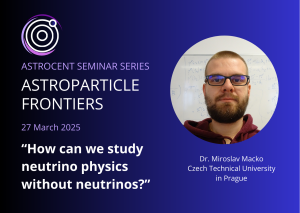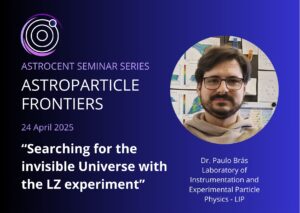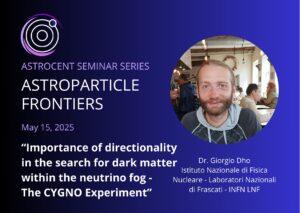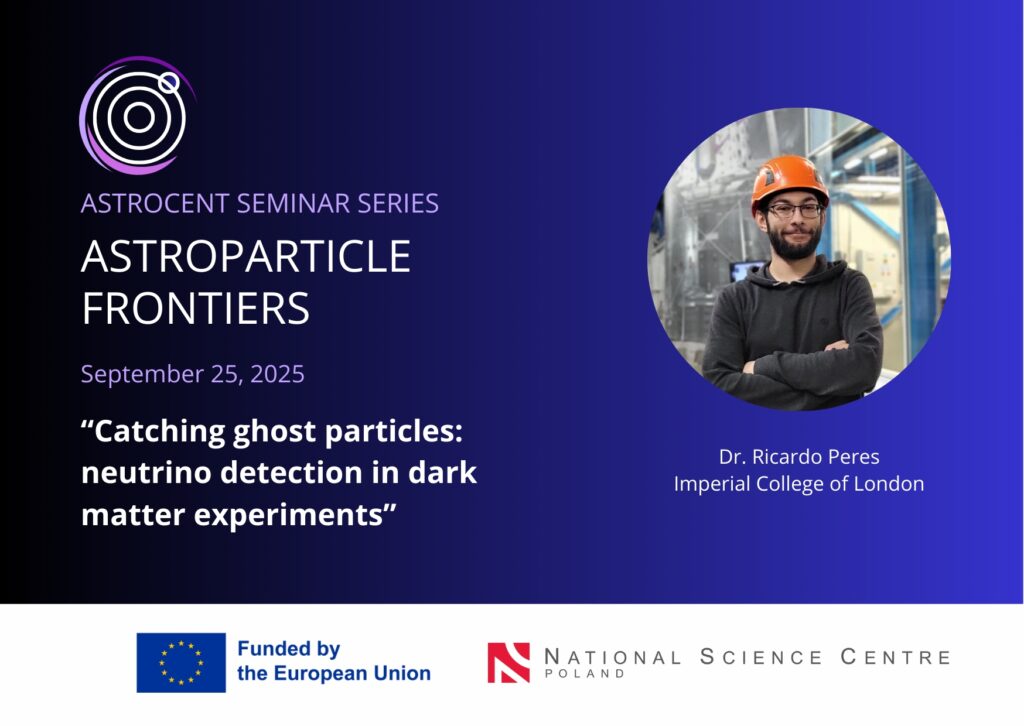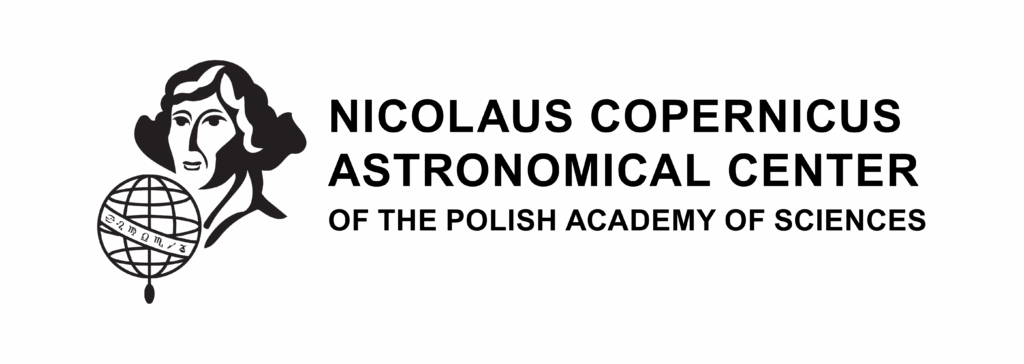
The Astroparticle Frontiers seminar series, organised by Astrocent, aims to foster knowledge exchange by bringing together experts in astrophysics, particle physics, and related fields. The seminars will take place on the last Thursday of each month in a hybrid format, with the physical venue being Astrocent at ul. Rektorska 4, 00-614 Warsaw, Poland.
Schedule:
– Kick-off seminar: March 27, 2025
– Frequency Seminars: last Thursday of each month (except July, August, and December)
– Time: 14:00 CET
– Format: hybrid (in-person at Astrocent, ul. Rektorska 4, 00-614 Warsaw, Poland & online)
Participants who REGISTER will receive seminar details in advance, including speaker information and access links before each event.
***
SEMINAR 1: HOW CAN WE STUDY NEUTRINO PHYSICS WITHOUT NEUTRINOS?
Date: 27 March 2027
Speaker: Dr. Miroslav Macko, Czech Technical University in Prague (Czech Republic)
Neutrino physics has gradually gained its importance during the last decades. In last years it became one of the fastest growing fields of particle physics. There are various unanswered and fundamental questions which are crucial to be understood to fully enter the era beyond the Standard Model. We still do not know what the masses of the neutrinos are, what is the nature of the neutrino (Dirac or Majorana) and we also do not know whether the sterile neutrinos exist. These are just some examples of the opened questions in neutrino physics. The mass of the neutrino, for example, can be studied by cosmological observations, very precise measurements of endpoint of beta decay of tritium or by study of Double Beta Decay.
The talk will be dedicated to the search for neutrino-less double-beta decay (0νββ) with SuperNEMO experiment (supernemo.org). The SuperNEMO detector is composed of source foil made of Se-82 (0νββ candidate), tracking detector composed of 2034 drift tubes in Geiger mode and 712 polystyrene scintillators for measurement of energy. This design is unique in the field of 0νββ thanks to the combination of particle tracking with calorimetric methods. Thanks to this, we are capable of reconstructing event topology and to perform particle identification. On top of the summed electron energy spectra, the standard observable in the field, SuperNEMO is capable to measure the angular distributions important for testing theoretical models. The first phase of SuperNEMO project – the demonstrator – is currently in the last phase of commissioning and should start measuring before the summer of 2025.
Young team from IEAP CTU in Prague plays an important role in the development of software for track reconstruction, automatic energy calibration but also in the search for newly proposed exotic modes of the Standard Model allowed two-neutrino double-beta decay (2νββ). The presentation will also be dedicated to a summary of our activities within the collaboration.
SEMINAR 2: Searching for the invisible Universe with the LZ experiment
Date: 24 April 2025
Speaker: Paulo Alexandre Brinca Costa Brás, LIP – Laboratory of Instrumentation and Experimental Particle Physics (Portugal)
Abstract:
Under our current paradigm of cosmology, our universe is overwhelmingly dominated by dark matter and dark energy. Despite a multitude of observations agreeing with the existence of dark matter, its nature is still mysterious and uncovering it is one of the major goals of modern physics. The LUX-ZEPLIN (LZ) experiment is primarily designed to detect interactions of dark matter in the form of weakly-interacting massive particles (WIMPs) using a 7 tonne dual-phase xenon time projection chamber (TPC). LZ has been acquiring science data since 2021 under stable operating conditions. Now, with a combined exposure of 4.2 tonne-years from all science campaigns, LZ has placed the most stringent limits on spin-independent WIMP-nucleon cross section down to 2.2×10-48 cm2 for a 43 GeV/c2 WIMP mass [1]. In this talk I’ll present the current status of the LZ experiment and its latest dark matter search results.
[1] J. Aalbers et al. (LZ Collaboration), “Dark Matter Search Results from 4.2 Tonne-Years of Exposure of the LUX-ZEPLIN (LZ) Experiment”, pre-print arXiv:2410.17036 [hep-ex], DOI:10.48550/arXiv.2410.17036 (submitted to PRL)
Short bio: Dr. Paulo Brás completed the PhD in Physics in 2021 by the University of Coimbra, with thesis titled “Sensitivity to the 0νββ decay of Xe-136 and development of Machine Learning tools for pulse classification for the LUX-ZEPLIN experiment”. Dr. Paulo Brás is currently a researcher at LIP – Laboratório de Instrumentação e Física Experimental de Partículas, at the Physics Department of the University of Coimbra, Portugal. He is a member of the LUX Collaboration since 2014 and member of the LUX-ZEPLIN (LZ) Collaboration since 2015. Starting from 2022, he is a member of the XLZD Collaboration and DRD2 Collaboration (CERN). He is also the lead researcher for the neutrinoless double beta decay searches in Xe-136 for the LUX-ZEPLIN experiment and the data Analysis Coordinator for the LUX-ZEPLIN experiment between 2022 and 2025. Since 2025 he is the deputy Physics Coordinator of this experiment.
SEMINAR 3: Importance of directionality in the search for dark matter within the neutrino fog – The CYGNO Experimen
Date: 15 May 2025
Speaker: Giorgio Dho, INFN – Laboratori Nazionali di Frascati (Italy)
Abstract:
In the last decades, the existence of Dark Matter (DM) has become well established, even though its nature is still elusive and unknown. The majority of the experiments searching for a direct signature of DM look at the energy of nuclear recoils induced by scattering with DM candidates. However, the motion of the Earth in the Galaxy produces an apparent wind of DM particles coming from the constellation Cygnus, making the direction of these nuclear recoils a very peculiar feature. The measurement of the directional information would greatly benefit the field, for example by enabling the rejection of neutrino coherent scattering with nuclei (CEvENs) which will reduce the sensitivity of experiments that only measure energy through what is known as the neutrino fog. Moreover, the angular distribution is expected to have a clear dipole structure, key for positive identification of DM, and even DM astronomy. Directionality can also help in signal to background discrimination for faster discovery.
Among different technologies craving to achieve directional detection, the gaseous TPC approach appears to be the most promising. In this context, the CYGNO experiment (a CYGNus TPC with Optical readout) aims for the development of a high precision optical readout gaseous TPC for directional rare event searches, such as neutrinos and dark matter. Its peculiar features are the use of sCMOS cameras and PMTs coupled to GEMs amplification of a helium-based gas mixture at atmospheric pressure, in order to achieve 3D tracking with head tail capability and background rejection down to O(keV) energy, to boost sensitivity to low WIMP masses. I will discuss the results of the largest prototype built, LIME, with an active volume of 50 L which was deployed in the Laboratori Nazionali del Gran Sasso. Moreover, the current steps towards the construction of a 0.4 m3 detector demonstrator will be described along with some R&D activities the experiment is carrying out.
Short bio: Dr. Giorgio Dho is a research scientist at the Laboratori Nazionali di Frascati (LNF) of INFN Italy. Dr. Giorgio Dho graduated in Physics in Turin in 2018 working on the calibration system of a sub-detector of the Auger experiment. Soon after the completion of his MSc degree he became a member of the CYGNO experiment working at the Gran Sasso Science Institute where he obtained a PhD in Astroparticle Physics in 2023. His research is focused on the development of readout of gaseous Time Projection Chambers for rare event searches, mainly tailored for dark matter direct detection. Dr. Giorgio Dho is currently the analysis coordinator of the CYGNO experiment and responsible for the testing of the low radioactivity components at the LNF laboratories.
SEMINAR 4: Catching ghost particles: neutrino detection in dark matter experiment
Date: 25 September 2025
Speaker: Dr. Ricardo Peres, MSCA Fellow, Imperial College of London (UK)
Abstract:
Abstract: Neutrinos are one of the most elusive particles in the Standard Model, making their direct detection a major experimental challenge despite their vast abundance in the universe. Detecting these mysterious particles provides not only answers to their own nature, but to a wide range of open questions of physics: from the interactions happening on the quantum level, to the evolution of stars on the far Universe.In this talk, I will outline our current picture of neutrinos, focusing their importance in current day physics, and discuss the recent reported hints of solar neutrino detection in liquid xenon by the XENONnT and PandaX experiments, as well as perspectives for further neutrino detection in liquid xenon experiments.
Short bio: Dr. Ricardo Peres is an astroparticle physicist focusing on the search for dark matter, supernova neutrinos, and liquid xenon detector R&D. He completed his PhD at the University of Zurich, where he worked on WIMP dark matter searches with XENONnT, explored the experiment’s sensitivity to galactic supernova neutrinos, and developed the optical readout of Xenoscope, a 2.6 m-tall liquid xenon TPC. Currently, Dr. Ricardo Peres is a Marie Skłodowska-Curie fellow at Imperial College London. He is a member of the LZ experiment and his project explores optical readout solutions for the next-generation xenon observatory, XLZD.
